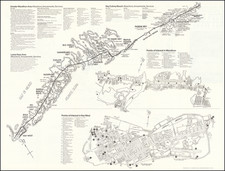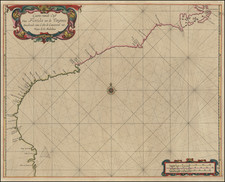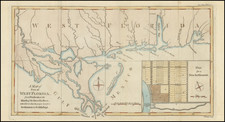Fascinating contemporary panoramic photograph showing the aftermath of the devasting Great Miami Hurricane of 1926, showing a stretch of Miami Bay Front Park, including the iconic Royal Palm Hotel (at the right).
The map showcases the destruction to this Miami landmark, which led to its demolition in 1926.
The Great Miami Hurricane of 1926
By 1926, Dade County and the Greater Miami area had seen rapid population growth and extensive construction, with the population surpassing 100,000—a significant increase from the 42,753 recorded in the 1920 census. The burgeoning city expanded, incorporating neighboring settlements such as Lemon City, Cocoanut Grove, and Little River. Miami Beach, created on barrier islands across Biscayne Bay, was a hive of new building activity. The U.S. Government, recognizing Miami's potential for growth and economic importance, had relocated a cooperative weather station to the city in 1900 and established a first-order Weather Bureau Office in 1911.
The Great Miami Hurricane of 1926, originating from Cape Verde, was first detected by ship reports in the central tropical Atlantic on September 11. It bypassed established Caribbean reporting channels, thus remaining largely untracked. The centralized storm warning system in Washington, D.C., failed to issue adequate warnings to Miami until less than 24 hours before the hurricane struck. Hurricane warnings were only raised on the evening of September 17 by the Miami Weather Bureau Office, led by Richard Gray.
As the hurricane made landfall on September 18, residents, inexperienced with hurricanes, mistakenly ventured outside during the eye's temporary calm, believing the storm had passed. This interlude was brief, and the hurricane's fiercest part soon followed, bringing a 10-foot storm surge that flooded Miami Beach and areas of the city.
The aftermath was devastating, with the Red Cross reporting 372 fatalities, over 6,000 injuries, and damages equivalent to over $164 billion in today's currency. The hurricane struck Florida again near Pensacola on September 20 before weakening as it moved to Mississippi and Louisiana.
Royal Palm Hotel
The Royal Palm Hotel was inaugurated on January 16, 1897. This grand resort hotel was the brainchild of railroad magnate Henry Flagler, a key figure in Florida's development. The hotel, renowned for its colossal structure, was one of the pioneer establishments in the Miami region, conveniently located on the north bank of the Miami River with a scenic view of Biscayne Bay.
Rising five stories with an additional sixth-floor salon, the Royal Palm Hotel was a beacon of modernity in the late 19th century, featuring the first electric lights, elevators, and swimming pool in the city. Its architectural footprint extended 680 feet along the riverbank, complemented by an expansive veranda. Styled as "modern Colonial," the hotel was a testament to decorous luxury, offering 450 guest rooms and suites, with sizes averaging twelve feet by eighteen feet.
The hotel catered to guests with a variety of amenities, including two dining rooms—one for the main guests and another designated for maids and children—along with private dining areas. Recreational facilities included parlors, a billiards room, other game rooms, and a significant ballroom. The Royal Palm also featured ample dressing room space adjacent to the swimming pool.
Operational facilities such as the boiler room, electric plant, kitchens, laundry, and ice-makers were housed in a separate structure to maintain the hotel's aesthetic. The staff was a robust ensemble of 300 employees, including sixteen cooks. Unique for its time, the hotel had permission to serve alcohol to its guests during the tourist season, despite the prevalent prohibition in the new city of Miami.
After 33 years of operation, the hotel's history came to a close. It was ultimately demolished in 1930 after being condemned due to the extensive damages it sustained from the 1926 hurricane and a termite infestation.












![[ Florida Indians - Destroying the Enemy's Towns By Night ] Hostium oppida noctu incendendi ratio. XXXI.er absagen](https://storage.googleapis.com/raremaps/img/small/97385.jpg)

![(California Oil Fields) [15 original photographs of Tupman Lease oil derricks and oil facilities at Taft, Kern County, California]](https://storage.googleapis.com/raremaps/img/small/94701.jpg)

